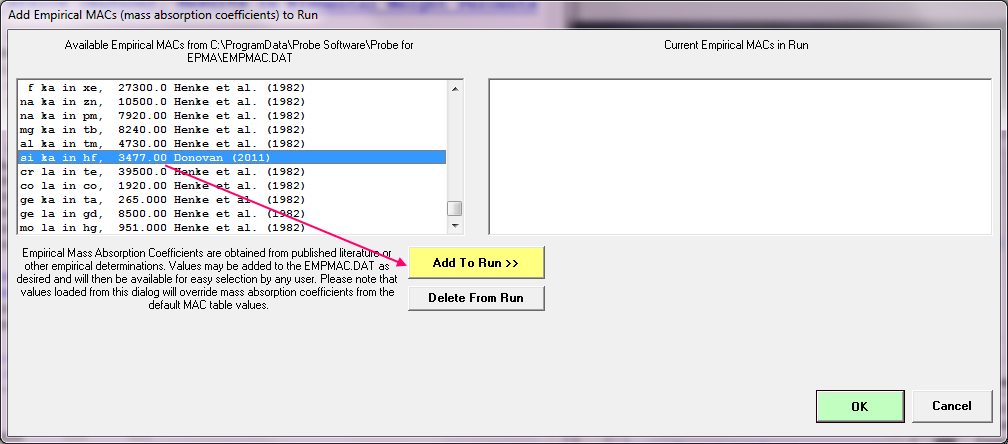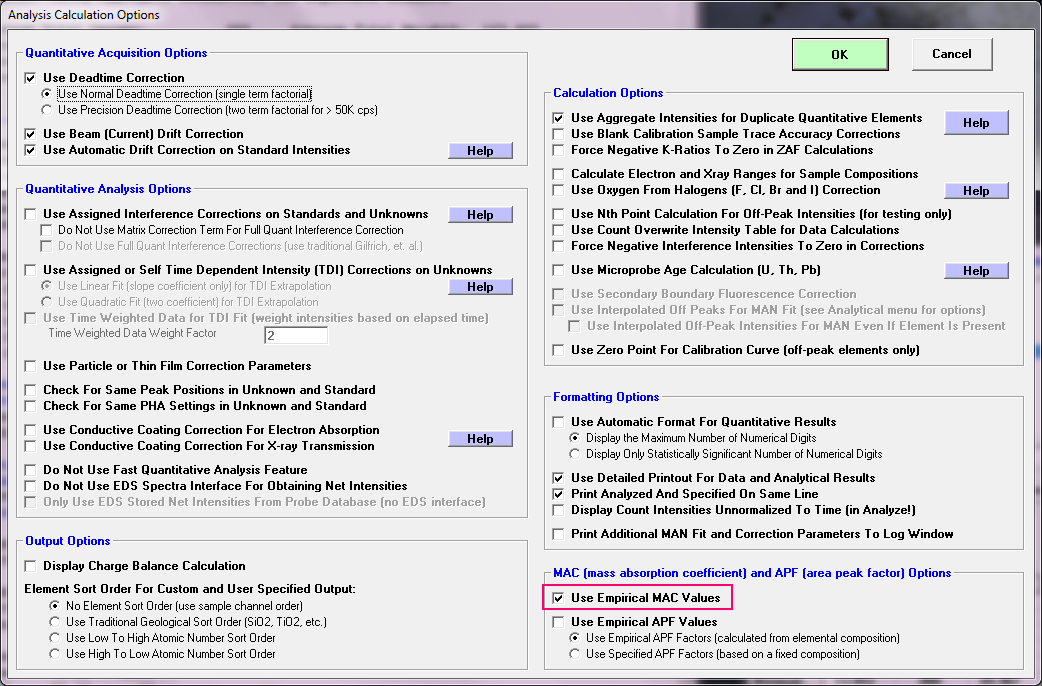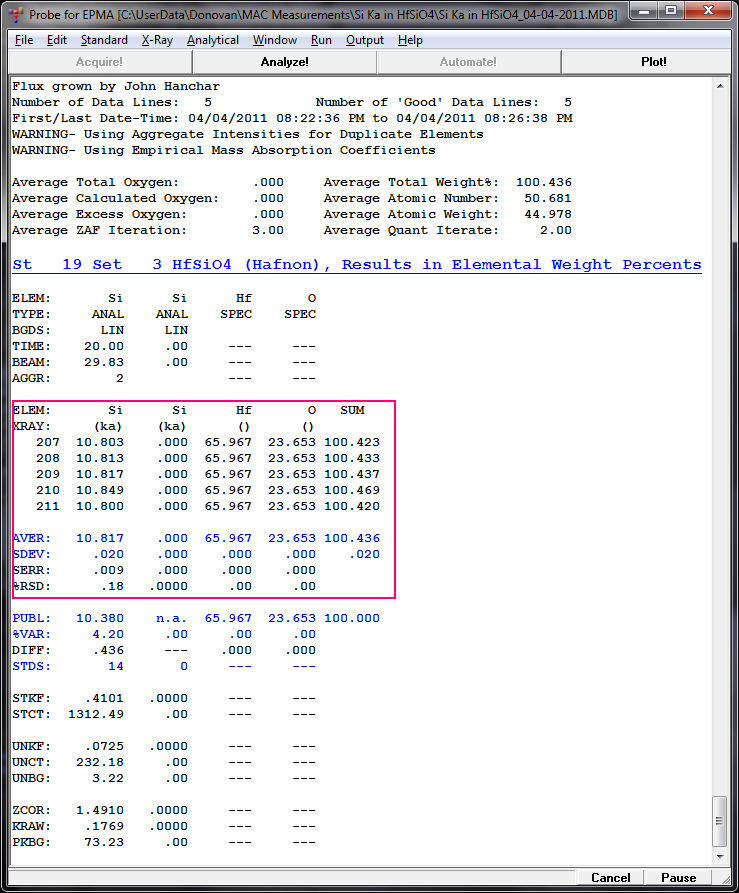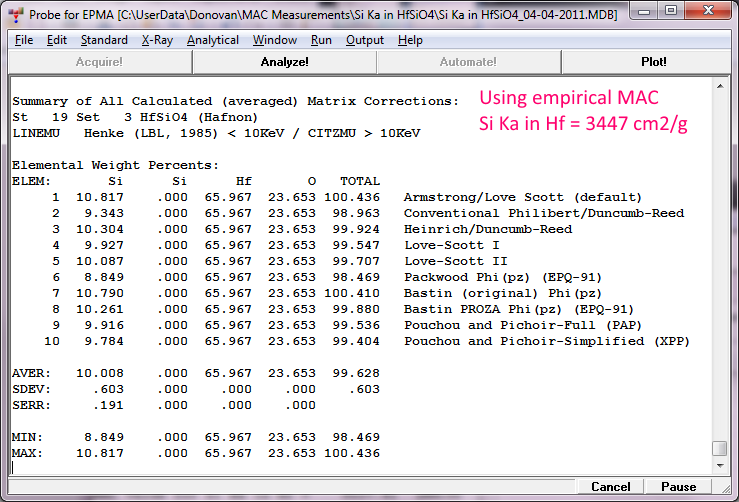Continuing from the previous post, to experimentally determine a mass absorption coefficient (MAC), we start with a material that contains the specified emitter and absorber pair with a known composition. Ideally this material is a binary composition, but often that is not available. Fortunately using an iterative technique such as the one Pouchou developed, a method to extract MACs for a specific emitter absorber pair can be performed, even in a complex matrix, when utilizing his XMAC program.
So now we make intensity measurements for the emitting x-ray in question, over a range of beam energies and load the intensities using the XMAC application input control or by loading an edited .XMC file (see example file attached below) as seen here, after clicking the Iexp button to display the intensities:

Next we click the m.a.c. button to perform the iterative MAC calculation as seen here:

Note the .XMC file format (a simple text file which can be edited using NotePad or another text editor):
3,1 <--- number of elements, number of datasets (usually 1)
"Si",.1038023 <--- composition in weight fraction
"Hf",.6596766
"O",.2365212
40 <--- spectro angle
90 <--- azimuth angle
0 <--- tilt angle
40 <--- effective takeoff angle
"Si","Ka" <--- emitting element and x-ray line (Ka, Kb, La, Lb, Ma, Mb)
2 <--- absorber index (Hf in this case)
8 <--- number of intensity measurements
4,13.3 <- keV beam energy, intensity in cps/nA
6,38.91
8,65.54
10,89.44
12,108.85
16,133.51
22,144.91
26,142.67
Once we have our experimentally determined MAC, we can add it to the empirical MAC text file that comes with CalcZAF and Probe for EPMA. In this case, the Si Ka in Hf MAC is already entered, as we can see in the EMPMAC.DAT text file, which is found in the C:\ProgramData\Probe Software\Probe for EPMA folder:
"b" "ka" "b" 3400 "Bastin (1992)"
"b" "ka" "b" 3500 "Pouchou (1998)"
"b" "ka" "b" 3068 "Donovan (2011)"
"b" "ka" "c" 6500 "Bastin (1992)"
"b" "ka" "n" 11200 "Bastin (1992)"
"b" "ka" "n" 11000 "Pouchou (1998)"
"b" "ka" "n" 10421 "Donovan (2011)"
"b" "ka" "mg" 59500 "Pouchou (1998)"
"b" "ka" "mg" 54500 "Donovan (2011)"
"b" "ka" "al" 64000 "Bastin (1992)"
"b" "ka" "si" 84000 "Bastin (1992)"
"b" "ka" "ti" 14700 "Bastin (1992)"
"b" "ka" "v" 17700 "Bastin (1992)"
"b" "ka" "cr" 20200 "Bastin (1992)"
"b" "ka" "fe" 27300 "Bastin (1992)"
"b" "ka" "co" 33400 "Bastin (1992)"
"b" "ka" "ni" 42000 "Bastin (1992)"
"b" "ka" "zr" 4000 "Bastin (1992)"
"b" "ka" "nb" 4600 "Bastin (1992)"
"b" "ka" "mo" 4550 "Bastin (1992)"
"b" "ka" "la" 2500 "Bastin (1992)"
"b" "ka" "ta" 22500 "Bastin (1992)"
"b" "ka" "w" 21400 "Bastin (1992)"
"b" "ka" "u" 8200 "Bastin (1992)"
"b" "ka" "b" 3471 "Pouchou (1992)"
"b" "ka" "c" 6750 "Pouchou (1992)"
"b" "ka" "n" 11000 "Pouchou (1992)"
"b" "ka" "o" 16500 "Pouchou (1992)"
"b" "ka" "al" 64000 "Pouchou (1992)"
"b" "ka" "si" 80000 "Pouchou (1992)"
"b" "ka" "ti" 15000 "Pouchou (1992)"
"b" "ka" "v" 18000 "Pouchou (1992)"
"b" "ka" "cr" 20700 "Pouchou (1992)"
"b" "ka" "fe" 27800 "Pouchou (1992)"
"b" "ka" "co" 32000 "Pouchou (1992)"
"b" "ka" "ni" 37000 "Pouchou (1992)"
"b" "ka" "zr" 4400 "Pouchou (1992)"
"b" "ka" "nb" 4500 "Pouchou (1992)"
"b" "ka" "mo" 4600 "Pouchou (1992)"
"b" "ka" "la" 2500 "Pouchou (1992)"
"b" "ka" "ta" 23000 "Pouchou (1992)"
"b" "ka" "w" 21000 "Pouchou (1992)"
"b" "ka" "u" 7400 "Pouchou (1992)"
"c" "ka" "b" 39000 "Pouchou (1992)"
"c" "ka" "c" 2170 "Pouchou (1992)"
"c" "ka" "si" 35000 "Pouchou (1992)"
"c" "ka" "ti" 8097 "Pouchou (1992)"
"c" "ka" "v " 8850 "Pouchou (1992)"
"c" "ka" "cr" 10700 "Pouchou (1992)"
"c" "ka" "fe" 13150 "Pouchou (1992)"
"c" "ka" "zr" 25000 "Pouchou (1992)"
"c" "ka" "nb" 24000 "Pouchou (1992)"
"c" "ka" "mo" 20500 "Pouchou (1992)"
"c" "ka" "hf" 18000 "Pouchou (1992)"
"c" "ka" "ta" 17000 "Pouchou (1992)"
"c" "ka" "w" 18000 "Pouchou (1992)"
"n" "ka" "b" 15800 "Pouchou (1992)"
"n" "ka" "n" 1640 "Pouchou (1992)"
"n" "ka" "al" 13800 "Pouchou (1992)"
"n" "ka" "si" 17000 "Pouchou (1992)"
"n" "ka" "ti" 4270 "Pouchou (1992)"
"n" "ka" "v " 4950 "Pouchou (1992)"
"n" "ka" "cr" 5650 "Pouchou (1992)"
"n" "ka" "fe" 7190 "Pouchou (1992)"
"n" "ka" "zr" 24000 "Pouchou (1992)"
"n" "ka" "nb" 25000 "Pouchou (1992)"
"n" "ka" "mo" 25800 "Pouchou (1992)"
"n" "ka" "hf" 14000 "Pouchou (1992)"
"n" "ka" "ta" 15500 "Pouchou (1992)"
"o" "ka" "li" 1600 "Bastin (1992)"
"o" "ka" "b" 8550 "Bastin (1992)"
"o" "ka" "o" 1200 "Bastin (1992)"
"o" "ka" "f" 1850 "Love et al. (1974)"
"o" "ka" "ne" 2750 "Love et al. (1974)"
"o" "ka" "na" 3630 "Love et al. (1974)"
"o" "ka" "mg" 5170 "Bastin (1992)"
"o" "ka" "mg" 5918 "Donovan (2011) MgO"
"o" "ka" "al" 6720 "Bastin (1992)"
"o" "ka" "si" 8790 "Bastin (1992)"
"o" "ka" "p" 9820 "Love et al. (1974)"
"o" "ka" "s" 12400 "Love et al. (1974)"
"o" "ka" "cl" 14300 "Love et al. (1974)"
"o" "ka" "ar" 16100 "Love et al. (1974)"
"o" "ka" "k" 20500 "Love et al. (1974)"
"o" "ka" "ca" 24600 "Love et al. (1974)"
"o" "ka" "sc" 26800 "Love et al. (1974)"
"o" "ka" "ti" 19900 "Bastin (1992)"
"o" "ka" "ti" 21046 "Donovan (2011) TiO2"
"o" "ka" "v" 35463 "Donovan (2011) V2O3"
"o" "ka" "v" 40509 "Donovan (2011) V2O5"
"o" "ka" "cr" 2900 "Bastin (1992)"
"o" "ka" "mn" 3470 "Bastin (1992)"
"o" "ka" "fe" 4000 "Bastin (1992)"
"o" "ka" "co" 4500 "Bastin (1992)"
"o" "ka" "ni" 5120 "Bastin (1992)"
"o" "ka" "cu" 5920 "Bastin (1992)"
"o" "ka" "zn" 6350 "Bastin (1992)"
"o" "ka" "ga" 7090 "Bastin (1992)"
"o" "ka" "y" 15100 "Bastin (1992)"
"o" "ka" "zr" 16200 "Bastin (1992)"
"o" "ka" "nb" 17100 "Bastin (1992)"
"o" "ka" "mo" 18000 "Bastin (1992)"
"o" "ka" "ru" 19700 "Bastin (1992)"
"o" "ka" "sn" 15050 "Bastin (1992)"
"o" "ka" "ba" 4560 "Bastin (1992)"
"o" "ka" "la" 3600 "Bastin (1992)"
"o" "ka" "ta" 10600 "Bastin (1992)"
"o" "ka" "w " 11300 "Bastin (1992)"
"o" "ka" "pb" 11000 "Bastin (1992)"
"o" "ka" "bi" 12100 "Bastin (1992)"
"o" "ka" "u" 8973 "Donovan (2011)"
"f" "ka" "xe" 27300 "Henke et al. (1982)"
"na" "ka" "zn" 10500 "Henke et al. (1982)"
"na" "ka" "pm" 7920 "Henke et al. (1982)"
"mg" "ka" "tb" 8240 "Henke et al. (1982)"
"al" "ka" "tm" 4730 "Henke et al. (1982)"
"si" "ka" "hf" 3477 "Donovan (2011)"
"cr" "la" "te" 39500 "Henke et al. (1982)"
"co" "la" "co" 1920 "Henke et al. (1982)"
"ge" "ka" "ta" 265 "Henke et al. (1982)"
"ge" "la" "gd" 8500 "Henke et al. (1982)"
"mo" "la" "hg" 951 "Henke et al. (1982)"
For additional empirical MAC entries simply add another line to the file using the same format as the other lines (details are found in the PFE User Reference manual and the links in the previous post), again using a text editor such as NotePad. Once the EMPMAC.DAT file is properly edited for any new MAC entries, we can start CalcZAF or PFE applications and click the Analytical | Empirical MACs menu as seen here:

Now we load the specified empirical MAC(s):

and click OK:

It should be noted that when you have added a new empirical MAC to your run and clicked OK in the above dialog, the Use Empirical MACs flag will automatically be set, but it can be toggled on and off from the Analytical | Analysis Options dialog as seen here:

Once we have our empirical MAC(s) loaded, when can re-analyze the sample as seen here:

Much better totals now. And in fact if we select the Use All Matrix Corrections checkbox in the Analyze! window we see a very nice set of average compositions:

I hope this helps, but please let me know if anyone has any questions at all.